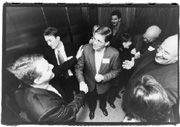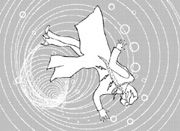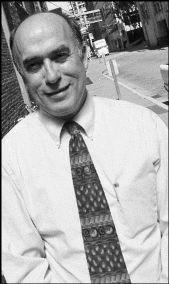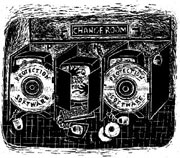THE LOUNGE is dark and the music loud. Bottled beer and single-malt whiskeys help lubricate the socializing as members of a mostly twenty- and thirtysomething crowd squeeze past one another or gather in tight clusters. Eagerly introducing themselves and making small talk before passing on to the next knot of people, they have a hungry look in their eyes as they ply the room, always searching for the score that will make the evening worthwhile. What sets this apart from the typical singles bar scene is that the small talk is mostly about hot concepts for new commercial endeavors and the participants are more likely to be exchanging business cards than bod-ily fluids.
This is Schmoozefest, one of the half-dozen or more regular matchmaking events happening in and around Seattle each month introducing high-tech start-ups to financial angels, venture capitalists, and the Puget Sound’s large pool of dot-com and IT millionaires.
A quiet sense of tension reflects the changing mood of investors, who have been chastened by the recent spate of bankruptcies and closings of start-up ventures. Investors have become more cautious than they were a year or two ago. Still, a tremendous amount of cash is circulating through Puget Sound, money that won’t grow without fertile ground, so the search continues. As a result, the organized schmoozes have become one of the most popular ways to bring a fool and his money together or, at least, get them an introduction
Schmoozing (the word comes from the Yiddish term for glad-handed socializing) has been an integral part of doing business for as long as some people have had good ideas and others money to back them. Handshake deals made over cocktails and canap鳠is a venerable tradition in the film industry, in which the parties one gets invited to have long served as the barometer of a person’s status. What sets the current Internet schmooze scene apart is the admittedly loose structure that has evolved and the forthright intent to put capital and start-ups in the same room together.
“With all the hype and craze of the Internet and everything happening in the ether, people tend to forget that most business gets done in a face-to-face manner,” says Robert Nachbar, director of communications for iStart Ventures, a business incubator.
Schmoozefest is the creation of local venture capitalist John Staenberg, who invites close to 4,000 Internet entrepreneurs and angels to meet at events around town, usually on the first Thursday of every other month. Other schmooze events have their own, quite different personalities.
Dot Tales and Cocktails holds the distinction of being the least formal of any of the organized schmoozes. Entry is determined by RSVPing the group’s Web site (www.dottales.com) and showing up. According to Chief Soir饠Officer Khody Golshan, the only rule at the group’s biweekly get-together is that the schmoozer has to buy the schmoozee a drink. Since they do not screen guests or provide name tags, they warn that “half the fun” is finding out who the fellow schmoozers are.
Mark Long, who heads up Zombie, a game development company, takes the credit for launching the schmooze scene in Seattle. “We started Demo Club almost two years ago to try to raise money for a start-up of our own called CentralHQ.com, which is a vertical portal network for the military and their families,” said Long. “The idea came to us—it doesn’t seem new any longer because here are so many of these events in town—that bringing together the collective power of a bunch of start-ups would attract a lot of investors and be an optimal situation for both sides. You could meet more investors than you could schedule in a year’s worth of appointment in one evening, and an angel investor could see 12 companies in the time that it would take to get one pitch.” Long’s invitation-only event, usually held at the Speakeasy, has recently joined an international 70-city network of schmooze events called First Tuesday, with the first event held this week at EMP’s Sky Church.
Joanna Alexander, president of CentralHQ.com, says the real reason for facilitating the schmoozes is remembering what it’s like to be struggling with a start-up venture. “There’s so many months when you’re juggling everything and your margin is just so narrow, and yet for years, you’ve dreamed about having this business,” she says. “It’s so much more than just your paycheck; it’s your whole dream that you’ve had growing up. We really get what it means to have that dream.”
ON THE FORMAL END of the schmooze scale is TechViews, which takes place on the 75th and 76th floors of the Bank of America Building. In contrast to Schmoozefest, where the dress code is “come as you’d like to be” and polo shirts proliferate, TechViews hews to the dress code of the Columbia Tower Club, an exclusive social club whose technology committee organizes the twice-yearly get-together. “Business casual” attire is the order of the evening, with running shoes and T-shirts specifically prohibited. A dozen or so invited start-ups looking for funding get to rub shoulders with well-established business leaders in the market for investment opportunities over “champagne, crisp martinis, and Chef Kenneth McNamee’s famous hors d’oeuvres.”
If the atmosphere at the Schmoozefests is like a singles mixer, TechViews resembles a dawn-of-the-century version of the cocktail party scene at the beginning of The Graduate. At last month’s event, a jazz cover band played Cannonball Adderly and Miles Davis standards in the lobby, while the upstairs was lit by the glow of laptops and desktop monitors rimming the banquet hall. Companies offering everything from cakes on demand to individualized love and investment advice based on astrological charts run looping PowerPoint presentations as their CEOs and flacks buttonhole passing investors.
Among them is Andy Crick, whose company, eTech-Chips, has invented a new type of computer chip for Internet appliances and other embedded computers. He is now looking for between $500,000 and $5 million in first-round funding. “We’re in a position to start manufacturing the product, except for the lack of money,” he says. “And we also need the money to put together a marketing organization.” The half-million dollars would buy him his marketing group, which could then secure the orders. “Of course, building the product without a market would be pointless, anyway,” Crick says.
The main entertainment at TechViews is “the Elevator Pitch Game.” Five finalists from among the night’s presenters stand in a makeshift elevator set and deliver a sales talk lasting 75 seconds—or the time it takes a ground-floor elevator to reach the top of Columbia Tower—to a panel of three VC judges and a standing-room-only audience of over 200. The two best finalists are then brought back to face a series of pointed questions from the judges, who rate their presentations and give out awards.
The Best in Show winner: Nariman Nasser, a twentysomething former molecular biologist and creator of Lab Galaxy, a San Francisco start-up with a current staff of three. Her company offers a range of services for scientists, from secure online lab notebooks to a plan to help foreign developers navigate the red-tape maze to get their products approved for US distribution.
“The revenue stream on the FDA registration online form portion is based on a consultancy fee basis,” Nasser says. “The meat and potatoes of our revenue will come from the My Lab Galaxy, a desktop application.” In five years, she expects to have one in five foreign drug manufacturers and about one-sixth of the world’s five million biotech researchers as customers—and be raking in an estimated $75 million a year.
But for now, Nasser must be content with a $500 office supply gift certificate and, far more importantly, a few serious inquiries as the room empties out.
Outside the room, experienced investors compare notes on the correlation between a strong minute-plus opening pitch and the eventual success of the company. Enrique Godreau, managing director of Voyager Capital, said the one question he still hasn’t gotten answered about Nasser’s company is where the money will come from in the first few years of her operation. “I’m not sure what happens in year one, year two, year three, what the ramp-up is,” he says, “I’m trying to get a sense of exactly who the buyer is, what the sales cycle is, how you find the customers, in terms of your direct sales activities. Are your price points set at a level where you can support a direct sales force, or is a channel strategy required in order for you to reach your objective?”
Afterward, the club’s cocktail lounge is transformed into the Cigars, Port & Deal Making Room, where the high-stakes game of business-card poker continues for another hour or so.
Wheeling his computer and other presentation supplies out the door at night’s end, Andy Crick says he is “guardedly optimistic” about his success. “I talked to a lot of people. Of course, nobody makes any commitments right off the top, but there are people I need to call back and people who will call me back. So it’s a beginning, which is what I wanted.”








